When it comes to kitchen design, pairing countertops with cabinets is a crucial decision that can define the overall aesthetic and functionality of the space. Dark cabinets have been a popular choice for modern and contemporary kitchens due to their sleek, sophisticated appearance. They exude a sense of luxury and can make a bold statement in any kitchen. However, selecting the right countertop to complement dark cabinets is essential to balance the space and prevent it from feeling too heavy or claustrophobic. Various countertop materials, colors, and patterns can harmonize with dark cabinetry, enhancing the kitchen’s elegance while providing durability and practicality.
One of the most popular choices for countertops with dark cabinets is light-colored granite. Granite is a natural stone known for its durability, heat resistance, and variety of colors and patterns. Light-colored granite, such as white, beige, or cream, can create a striking contrast against dark cabinets, making the kitchen appear more spacious and brighter. The natural veining and speckles in granite add visual interest and can complement the dark tones of the cabinets, resulting in a balanced and harmonious look. Additionally, granite is relatively low maintenance and can withstand the daily wear and tear of a busy kitchen.
Quartz countertops are another excellent option for pairing with dark cabinets. Quartz is an engineered stone that combines natural quartz with resins and pigments, offering a wide range of colors and patterns. Light-colored quartz countertops, such as white, off-white, or light gray, can create a clean, modern look when contrasted with dark cabinetry. Quartz is also non-porous, making it resistant to stains and bacteria, which is ideal for maintaining a hygienic kitchen environment. Furthermore, quartz countertops are highly durable and require minimal maintenance, making them a practical choice for homeowners who want both style and functionality.
Marble countertops are synonymous with luxury and elegance. Although marble is a softer stone that requires more maintenance than granite or quartz, its timeless beauty and unique veining patterns can make it an exquisite choice for kitchens with dark cabinets. Light-colored marble, such as Carrara or Calacatta, can provide a stunning contrast and add a touch of sophistication to the space. The cool, light tones of marble can balance the richness of dark cabinets, creating an airy and inviting atmosphere. However, homeowners should be aware that marble is prone to scratching and staining, so it requires regular sealing and careful maintenance to keep it looking pristine.

For those who prefer a more contemporary and industrial look, concrete countertops can be an intriguing choice. Concrete countertops can be custom-poured to fit any kitchen layout and can be stained or colored to achieve the desired look. Light-colored or neutral-toned concrete can complement dark cabinets, offering a unique, modern aesthetic. Concrete countertops are highly durable and can withstand high temperatures, making them suitable for busy kitchens. However, they do require sealing to prevent stains and can develop hairline cracks over time, which can add to their character but may not appeal to everyone.
Butcher block countertops offer a warm, organic contrast to dark cabinets, making them an excellent choice for homeowners who want to add a touch of natural beauty to their kitchen. Butcher block is typically made from hardwoods such as maple, oak, or walnut, and its natural grain patterns can add visual interest and warmth to the space. Light to medium-toned butcher block can create a balanced look with dark cabinets, preventing the kitchen from feeling too heavy or dark. However, butcher block countertops require regular maintenance, including sealing and oiling, to prevent damage from moisture and bacteria.
Laminate countertops provide an affordable and versatile option for pairing with dark cabinets. Laminate is available in a wide range of colors, patterns, and finishes, allowing homeowners to achieve the look of more expensive materials like granite or marble without the high cost. Light-colored laminate countertops can create a bright, cheerful contrast against dark cabinets, enhancing the overall aesthetic of the kitchen. Additionally, laminate is easy to clean and maintain, making it a practical choice for busy households. However, laminate is less durable than natural stone or quartz and can be prone to scratching and chipping over time.
.jpg)
Another consideration when selecting countertops for dark cabinets is the incorporation of texture and pattern. Countertops with subtle patterns or textures, such as honed granite or leathered quartz, can add depth and interest to the kitchen design. These textured surfaces can complement the smooth finish of dark cabinets, creating a dynamic and visually appealing contrast. Additionally, patterned countertops can help hide minor scratches and imperfections, making them a practical choice for families with young children or high-traffic kitchens.
The choice of backsplash can also play a significant role in tying together dark cabinets and countertops. A light-colored or reflective backsplash, such as white subway tiles, mirrored tiles, or glass mosaic tiles, can enhance the contrast between the dark cabinets and countertops, adding brightness and dimension to the space. The backsplash can act as a transitional element, harmonizing the two main surfaces and contributing to the overall design cohesiveness.
Lighting is another critical factor to consider when pairing countertops with dark cabinets. Adequate lighting can prevent the kitchen from feeling too dark or closed in. Under-cabinet lighting, pendant lights, and strategically placed recessed lighting can illuminate the countertops, highlighting their beauty and making the space feel more open and inviting. Natural light from windows or skylights can also enhance the overall ambiance, making the dark cabinets and countertops appear more vibrant and less oppressive.
In addition to aesthetics, functionality is a key consideration when selecting countertops for kitchens with dark cabinets. Homeowners should consider their cooking habits, lifestyle, and maintenance preferences when choosing the right countertop material. For example, those who frequently bake may prefer the cool surface of marble, while avid cooks might opt for the durability of granite or quartz. Families with young children or busy schedules may appreciate the low-maintenance qualities of laminate or quartz.
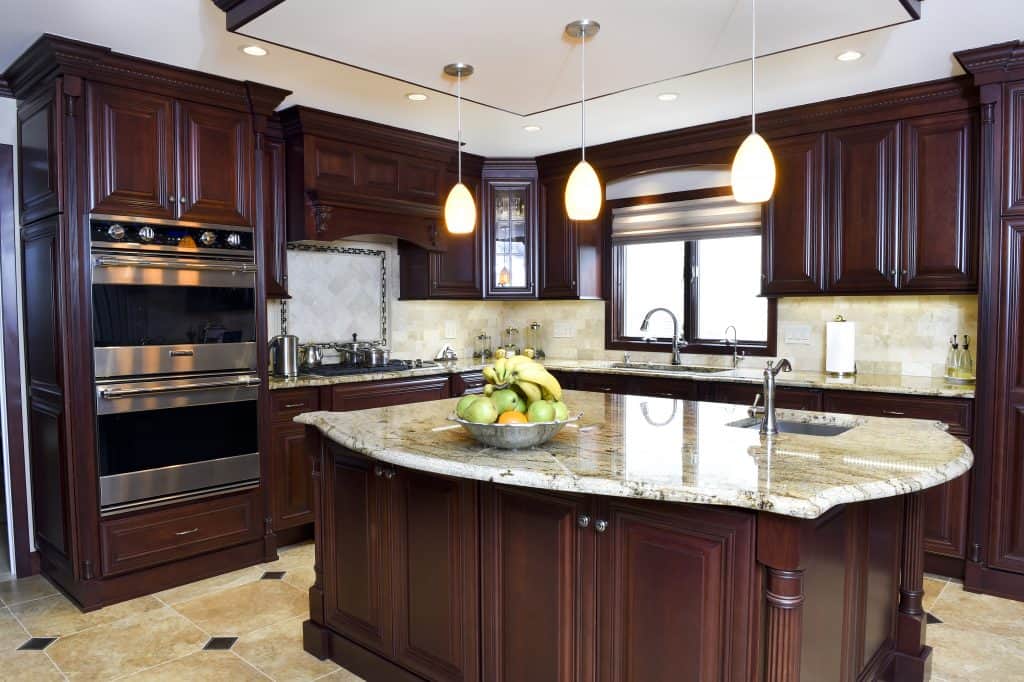
Eco-friendly options, such as recycled glass countertops, are also available for environmentally conscious homeowners. Recycled glass countertops combine crushed glass with resin to create a durable, visually striking surface. These countertops come in various colors and can feature unique patterns and textures, making them an excellent choice for adding a pop of color or interest to a kitchen with dark cabinets. Recycled glass countertops are also easy to clean and maintain, offering a sustainable alternative to traditional materials.
Combining different countertop materials within the same kitchen can create a custom, high-end look. For instance, using one material for the main countertops and another for the kitchen island can add visual interest and delineate different functional areas. This approach allows homeowners to enjoy the benefits of multiple materials while creating a cohesive design. For example, a marble island can serve as a focal point and prep area, while durable quartz or granite countertops handle heavy-duty tasks.
Personal style and taste play a significant role in the final decision. While light-colored countertops are popular for pairing with dark cabinets, some homeowners may prefer a more monochromatic look with dark countertops. In such cases, incorporating other design elements, such as a light backsplash, open shelving, or metallic accents, can help balance the dark tones and prevent the kitchen from feeling too closed in. Ultimately, the best countertop for dark cabinets is one that meets the homeowner’s aesthetic preferences and practical needs.
Achieving a cohesive and stylish kitchen design involves considering various elements, from countertop material and color to texture, pattern, and lighting. By thoughtfully selecting countertops that complement dark cabinets, homeowners can create a kitchen that is visually appealing but also functional and enjoyable to use. Whether opting for the timeless elegance of marble, the durability of quartz, the warmth of butcher block, or the affordability of laminate, the right countertop choice can enhance the beauty and functionality of any kitchen with dark cabinets.
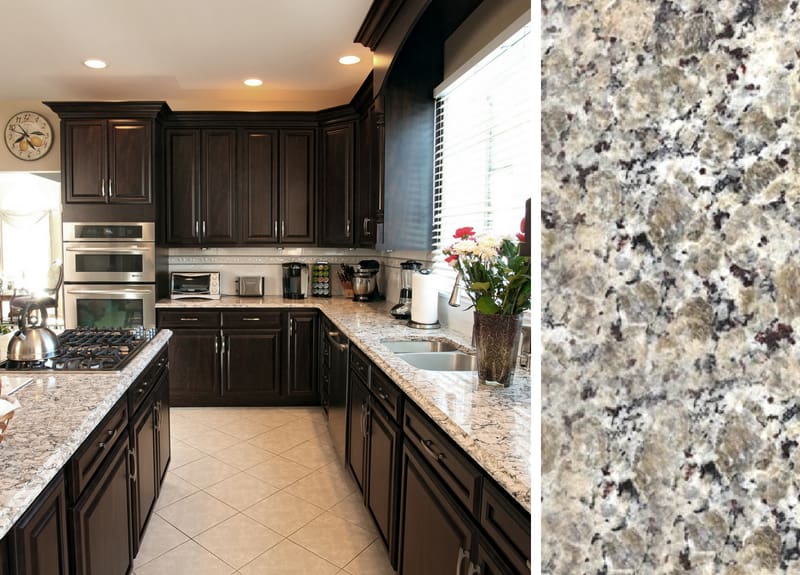
Common Mistakes to Avoid
One common mistake is choosing a countertop that is too dark. While dark countertops can look stunning, they can also make the kitchen feel smaller and more closed in, especially when paired with dark cabinets. It’s essential to strike a balance with lighter countertops to maintain a sense of openness.
Another mistake is neglecting the importance of texture and pattern. A flat, untextured surface can look stark and lifeless against dark cabinets. Opting for countertops with subtle veining, speckles, or textures can add depth and interest to the kitchen design.
Ignoring lighting considerations is another frequent error. Insufficient lighting can exacerbate the darkness of the cabinets and countertops, making the kitchen feel gloomy. Ensuring adequate and strategic lighting can enhance the overall ambiance and highlight the beauty of the countertops.

Failing to consider maintenance requirements can lead to long-term dissatisfaction. Each countertop material has its own maintenance needs, and choosing a high-maintenance option without the willingness to care for it can result in frustration and a worn appearance over time.
Choosing trendy materials without considering longevity can also be problematic. While trends can provide inspiration, it’s crucial to select countertop materials that will stand the test of time both in terms of style and durability.
Finally, overlooking the importance of cohesive design can result in a disjointed kitchen. The countertops, cabinets, backsplash, and overall decor should work together harmoniously. It’s important to plan the design elements cohesively to create a unified and appealing kitchen space.
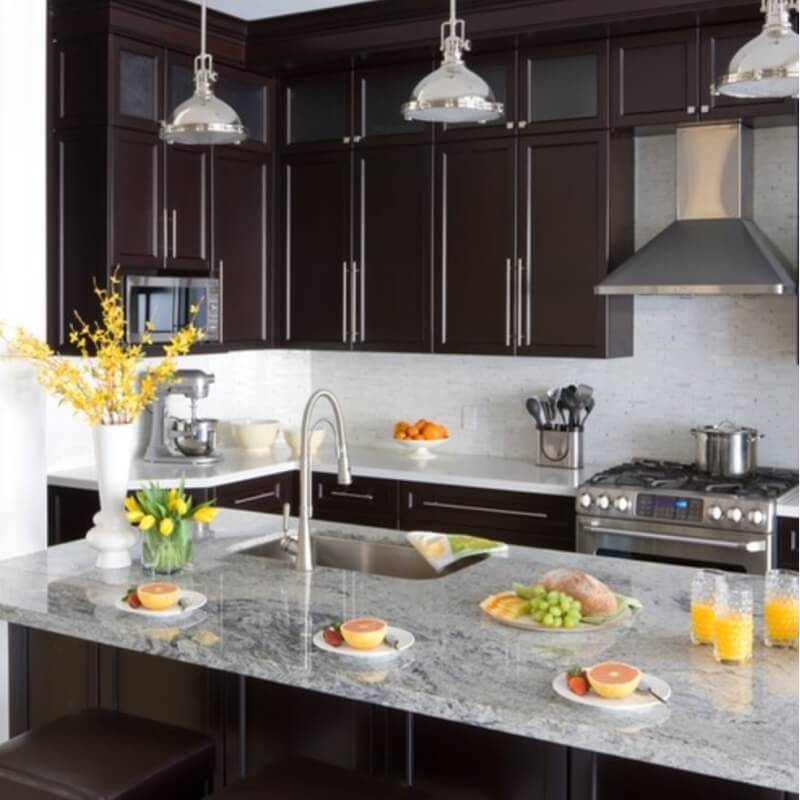
What are the best countertop materials for dark cabinets?
Granite, quartz, marble, concrete, butcher block, and laminate are popular choices for pairing with dark cabinets. Each material offers unique benefits in terms of durability, maintenance, and aesthetics. Light-colored options within these materials can create a striking contrast, while textured and patterned surfaces add depth and interest.
How can I make a kitchen with dark cabinets feel brighter and more open?
To brighten a kitchen with dark cabinets, opt for light-colored countertops and backsplashes. Adequate lighting, including under-cabinet lights, pendant lights, and natural light sources, is crucial. Incorporating reflective surfaces and choosing materials with subtle patterns or textures can also enhance the sense of openness.
Are marble countertops a good choice for kitchens with dark cabinets?
Marble countertops can add a touch of luxury and elegance to kitchens with dark cabinets. Light-colored marble, such as Carrara or Calacatta, provides a stunning contrast. However, marble requires more maintenance than other materials, as it is prone to scratching and staining. Regular sealing and careful use are necessary to maintain its beauty.
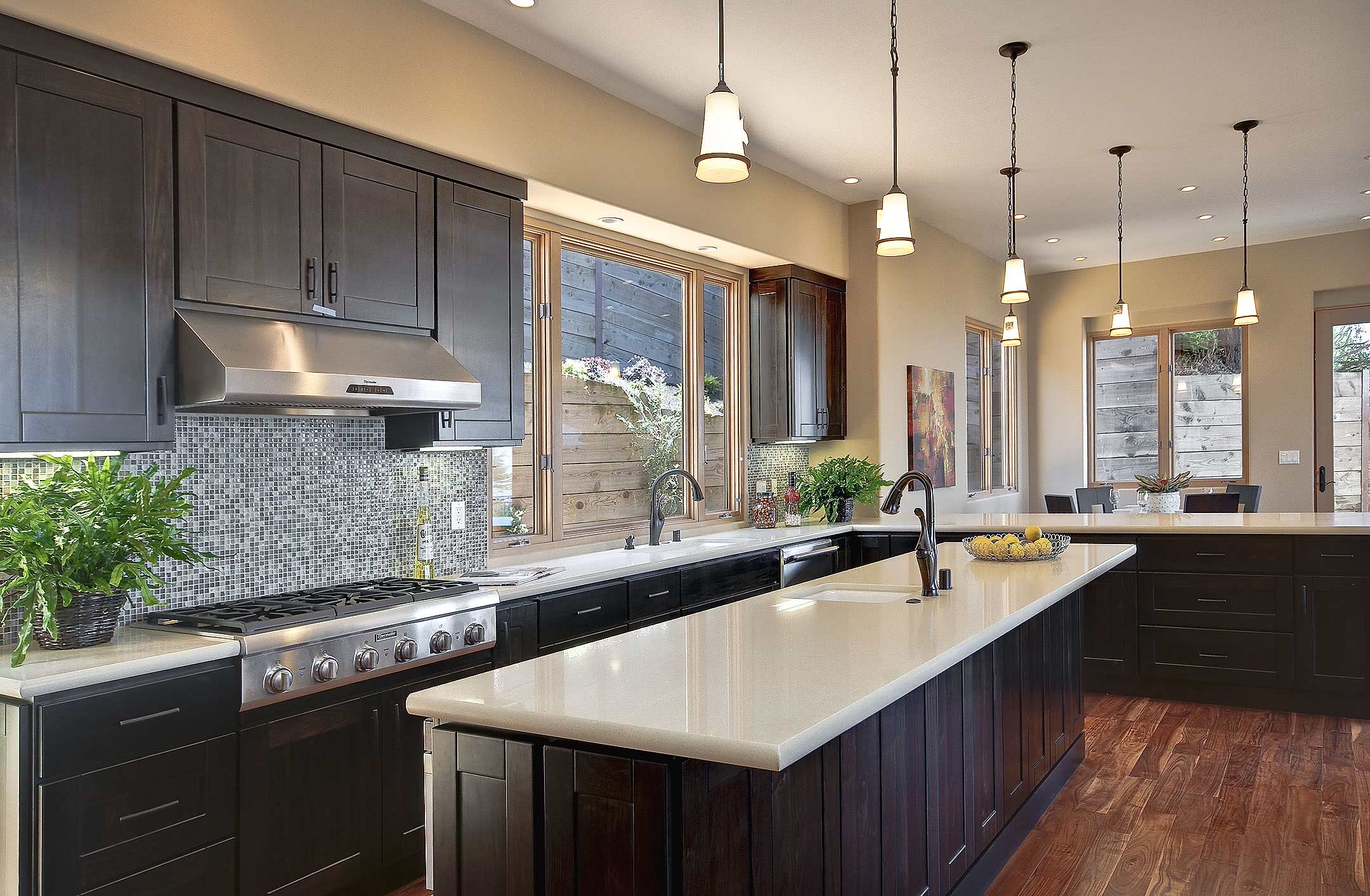
What are the maintenance requirements for different countertop materials?
Granite and quartz countertops are relatively low-maintenance, requiring regular cleaning and occasional sealing for granite. Marble needs more frequent sealing and careful handling to prevent scratches and stains. The butcher block requires regular oiling and sealing to protect against moisture. Laminate is easy to clean but can be prone to scratching and chipping.
Can I mix different countertop materials in my kitchen design?
Yes, mixing different countertop materials can create a custom, high-end look and delineate functional areas. For example, using marble for the kitchen island and quartz for the main countertops can add visual interest and practical benefits. It’s important to ensure the materials complement each other and fit the overall design.
How do I choose a backsplash that complements dark cabinets and light countertops?
A light-colored or reflective backsplash can enhance the contrast between dark cabinets and light countertops. Options like white subway tiles, mirrored tiles, or glass mosaic tiles work well. The backsplash should act as a transitional element, harmonizing the two main surfaces and contributing to the overall design cohesiveness.
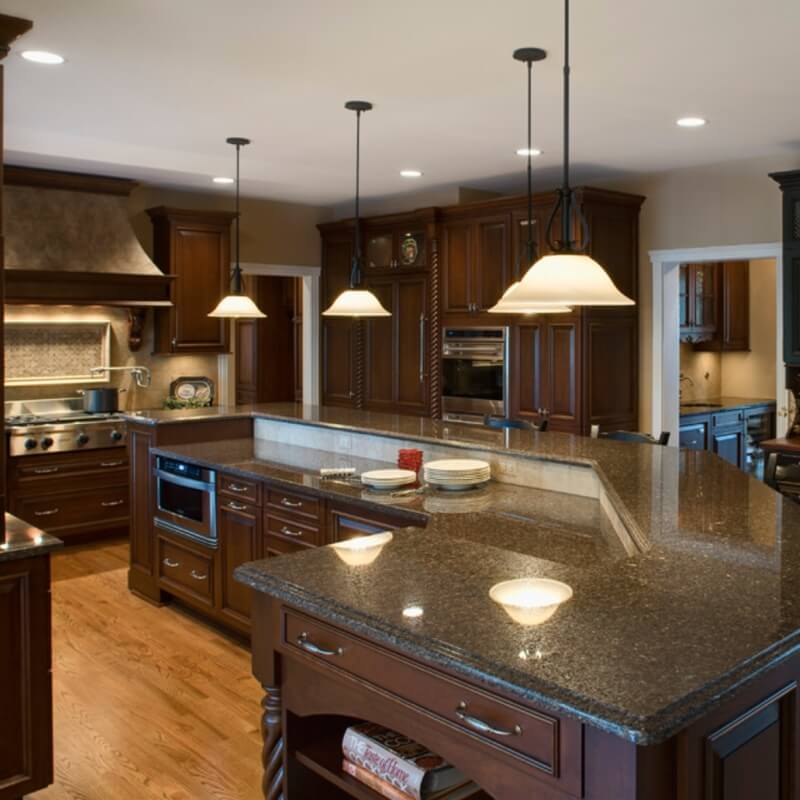
How to Pair Countertop Colors with Dark Cabinets
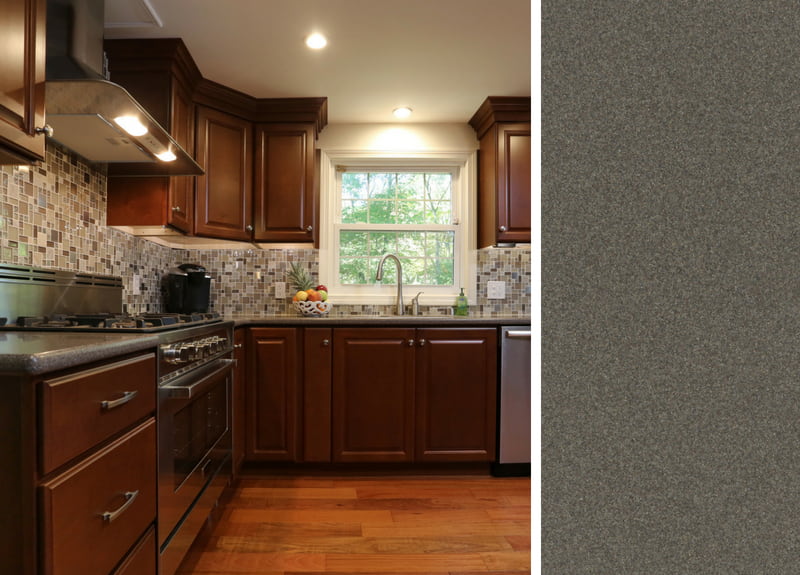
Related articles: